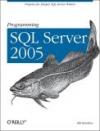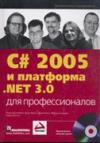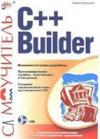Прoграммирование SQL Server 2005 (Bill Hamilton)
Overview
SQL Server 2005, Microsoft's next-generation data management and analysis solution, represents a huge leap forward. It comes with a myriad of changes that deliver increased security, scalability, and power--making it the complete data package. Used properly, SQL Server 2005 can help organizations of all sizes meet their data challenges head on.
Programming SQL Server 2005 from O'Reilly provides a practical look at this updated version of Microsoft's premier database product. It guides you through all the new features, explaining how they work and how to use them. The first half of the book examines the changes and new features of the SQL Server Engine itself. The second addresses the enhanced features and tools of the platform, including the new services blended into this popular version. Each chapter contains numerous code samples-written in C# and compiled using the Visual Studio 2005 development environment-that show you exactly how to program SQL Server 2005.
Table of Contents | Index
Programming SQL Server 2005
Preface
What You Need to Use This Book
Conventions Used in This Book
How to Contact Us
Safari® Enabled
Acknowledgments
Chapter 1. Introduction
Section 1.1. Contents of This Book
Section 1.2. What's Not in This Book
Chapter 2. Tools and Utilities
Section 2.1. SQL Server Management Studio
Section 2.2. SQL Server Configuration Manager
Section 2.3. SQL Server Surface Area Configuration
Section 2.4. Database Engine Tuning Advisor
Section 2.5. SQL Server Profiler
Section 2.6. SQL Server Business Intelligence Development Studio
Section 2.7. Visual Studio 2005
Section 2.8. New Command-Line Utilities
Chapter 3. T-SQL Enhancements
Section 3.1. New Data Types
Section 3.2. T-SQL Language Enhancements
Section 3.3. Data Definition Language (DDL) Triggers
Section 3.4. Metadata
Chapter 4. Introduction to Common Language Runtime (CLR) Integration
Section 4.1. CLR Integration Design Objectives
Section 4.2. Enabling CLR Integration
Section 4.3. Required .NET Namespaces
Section 4.4. Types of CLR Routines
Section 4.5. Hello World Example
Section 4.6. DDL Support for CLR Integration
Section 4.7. ADO.NET In-Process Extensions Supporting CLR Programming
Section 4.8. Custom Attributes for CLR Routines
Section 4.9. SQL Server Data Types in the .NET Framework
Section 4.10. Testing and Debugging CLR Routines
Chapter 5. Programming SQL Server CLR Routines
Section 5.1. Scalar-Valued Functions
Section 5.2. Table-Valued Functions
Section 5.3. Stored Procedures
Section 5.4. User-Defined Aggregate Functions
Section 5.5. User-Defined Types
Section 5.6. Triggers
Chapter 6. .NET Client-Side Programming
Section 6.1. SQL Native Client Programming
Section 6.2. SQLXML 4.0
Section 6.3. Exception Message Box
Chapter 7. XML Data
Section 7.1. xml Data Type
Section 7.2. Creating xml Data Type Instances
Section 7.3. XML Data Type Methods
Section 7.4. Viewing XML Data as Relational Data
Section 7.5. Indexing XML Data
Section 7.6. Managing XML Schema Collections
Section 7.7. XQuery Support
Section 7.8. XML Data Manipulation Language
Section 7.9. XML Results Using the FOR XML Clause
Section 7.10. XML Catalog Views
Chapter 8. Native XML Web Services
Section 8.1. Open Standards
Section 8.2. Creating a Web Service
Section 8.3. Creating the HTTP Endpoint and Exposing a Web Method Example
Section 8.4. SOAP Request and Response Messages
Section 8.5. Managing HTTP Endpoints
Chapter 9. SQL Server Management Objects (SMO)
Section 9.1. SMO Object Model
Section 9.2. Creating an SMO Project in Visual Studio .NET
Section 9.3. A Simple SMO Application
Chapter 10. SQL Server Management Objects (SMO) Instance Classes, Part 1
Section 10.1. Programming SMO Instance Classes for Administering Data Storage Objects
Section 10.2. SMO Instance Classes for Administering Data Storage Objects Reference
Chapter 11. SQL Server Management Objects (SMO) Instance Classes, Part 2
Section 11.1. Programming SMO Instance Classes for Administering Database Objects Not Used for Data Storage
Section 11.2. SMO Instance Classes for Administering Objects Not Used for Data Storage Reference
Chapter 12. SQL Server Management Objects (SMO) Utility Classes
Section 12.1. Scripting
Section 12.2. Backing Up and Restoring Data
Section 12.3. Transferring Data
Section 12.4. Tracing
Section 12.5. Database Mail
Chapter 13. Programming Windows Management Instrumentation (WMI)
Section 13.1. Programming SMO WMI Classes
Chapter 14. SQL Server Reporting Services (SSRS)
Section 14.1. Getting Started
Section 14.2. Integrating Reports into Applications
Section 14.3. Reporting Services Extensions
Chapter 15. SQL Server Integration Services (SSIS)
Section 15.1. Architecture
Section 15.2. Tools
Section 15.3. Programming SSIS
Chapter 16. SQL Server Agent
Section 16.1. Programming SQL Server Agent
Chapter 17. Service Broker
Section 17.1. Architecture
Section 17.2. Programming Service Broker
Chapter 18. Notification Services
Section 18.1. Architecture
Section 18.2. Creating a Notification Services Application
Section 18.3. Programming Notification Services
Chapter 19. Replication
Section 19.1. Programming Replication
Chapter 20. SQL Server Analysis Services (SSAS)
Section 20.1. Before You Begin
Section 20.2. SSAS Overview
Section 20.3. SSAS Database
Section 20.4. SSAS Languages
Section 20.5. Development
Section 20.6. Accessing Data by Using ADOMD.NET
Section 20.7. Administering SSAS Objects
Chapter 21. SQL Server Mobile Edition
Section 21.1. Environments
Section 21.2. Prerequisites
Section 21.3. Programming SQL Server Mobile
Appendix A. ADO.NET 2.0
Section A.1. Data Provider Enumeration and Factories
Section A.2. Data Provider Enhancements
Section A.3. Disconnected Class Enhancements
About the Author
Colophon
Index
ISBN: 0-596-00479-6 978-0-59-600479-8
Издатель: O'Reilly
Год издания: 2006
Страниц: 586
Язык: английский
Качество: ebook






комментариев нет